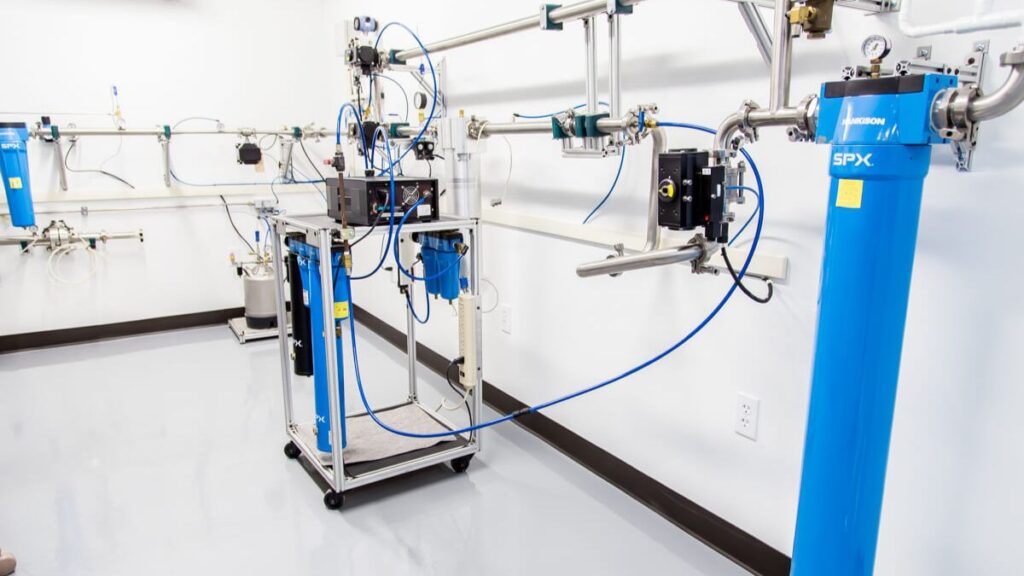Compressed air plays a critical role in surgery, dentistry, and food production, where purity standards are essential for safety. Contaminated air in medical settings can harm patients, while poor air quality in food production risks contamination. These industries require specialized air that meets strict standards, making advanced technologies vital for ensuring quality.
Understanding Air Purity Classifications
The foundation of compressed air quality lies in the ISO 8573-1 standard, which establishes purity classes based on three key contaminants: solid particles, water, and oil. Each contaminant receives a numerical classification, with lower numbers indicating higher purity levels.
For medical and dental applications, Class 1 purity is typically required across all three categories. This means:
- Solid particles: Maximum of 0.1 mg/m³ with particle sizes up to 0.1 microns
- Water content: Pressure dew point of -70°C or lower
- Oil content: Maximum of 0.01 mg/m³
Food processing applications may vary depending on whether the compressed air comes into direct contact with food products. Direct contact applications require the same Class 1 standards as medical use, while indirect applications might accept slightly lower purity levels.
These classifications aren’t arbitrary. Medical devices like ventilators and anesthesia machines introduce compressed air directly into patients’ respiratory systems. Even microscopic contaminants can cause serious complications, making these strict standards a matter of life and death.
Advanced Filtration and Drying Technologies
Achieving medical-grade air purity requires sophisticated filtration systems that work in stages to remove different types of contaminants. The process typically begins with pre-filtration to remove larger particles and moisture, followed by increasingly fine filtration stages.
High-efficiency particulate air (HEPA) filters form the backbone of most medical compressed air systems. These filters can remove 99.97% of particles measuring 0.3 microns or larger. Some systems incorporate ultra-low particulate air (ULPA) filters for even higher efficiency.
Oil removal presents unique challenges. Many facilities choose oil-less air compressors to eliminate oil contamination at the source. These compressors use alternative lubrication methods or operate without lubrication entirely, significantly reducing the risk of oil carryover into the compressed air stream.
Moisture control requires specialized drying equipment. Refrigerated dryers work well for many applications, but medical and food processing often demand desiccant dryers that can achieve the ultra-low dew points required by Class 1 standards. These systems use materials like activated alumina or molecular sieves to absorb water vapor from the compressed air.
Activated carbon filters provide an additional layer of protection by removing odors, tastes, and trace organic compounds that other filtration methods might miss. This proves especially important in food applications where even minute flavor contamination can affect product quality.
Industry-Specific Applications
Each industry leverages compressed air in unique ways that influence its specific quality requirements. Understanding these applications helps explain why such stringent standards exist.
Medical Applications
Hospitals and surgical centers use compressed air for life-critical applications. Ventilators rely on clean compressed air to deliver oxygen therapy to patients with respiratory difficulties. Anesthesia machines mix compressed air with anesthetic gases, requiring absolute purity to prevent patient complications.
Surgical instruments often depend on compressed air for operation. Pneumatic surgical tools, bone saws, and other devices must receive contaminant-free air to function properly and safely. Even minor particles can damage precision instruments or introduce infection risks.
Laboratory equipment represents another critical application. Blood analyzers, diagnostic machines, and research equipment use compressed air for various functions, from sample processing to instrument operation. Contaminated air can skew test results or damage sensitive components.
Dental Practice Requirements
Dental offices present unique compressed air challenges due to the variety of applications within a single facility. High-speed handpieces require oil-free air to prevent contamination of the oral environment. These devices operate at extremely high speeds, making them sensitive to even trace amounts of oil or particles.
Air/water syringes use compressed air to dry tooth surfaces and clear debris during procedures. Since this air enters patients’ mouths directly, it must meet the same purity standards as medical applications. Contaminated air can introduce bacteria or other pathogens into the oral cavity.
Curing lights and other dental equipment also rely on compressed air for cooling and operation. While these applications may not require direct patient contact, maintaining consistent air quality throughout the system simplifies maintenance and ensures reliability.
Food Processing Standards
Food manufacturing uses compressed air in numerous ways, each with different purity requirements based on contact levels. Direct contact applications include conveying food products, cleaning food contact surfaces, and operating packaging equipment where air touches the product.
Packaging operations often use compressed air to inflate bags, operate filling equipment, and power conveying systems. Contaminated air can introduce bacteria, odors, or foreign particles that compromise food safety and quality. Many facilities exceed minimum requirements to protect their brand reputation.
Indirect applications include powering pneumatic controls, operating non-contact equipment, and general facility operations. While these may not require the highest purity levels, maintaining consistent standards throughout the facility often proves more cost-effective than managing multiple air quality zones.
Maintenance Best Practices
Maintaining compressed air quality requires systematic approaches that go beyond basic equipment servicing. Regular monitoring forms the foundation of any effective maintenance program.
Air quality testing should occur at multiple points throughout the system, not just at the compressor outlet. Sampling locations near point-of-use applications help identify potential contamination sources and verify that filtration systems are performing correctly.
Filter replacement schedules must account for actual operating conditions rather than relying solely on manufacturer recommendations. High-particulate environments may require more frequent changes, while facilities with excellent pre-filtration might extend replacement intervals safely.
Condensate management plays a crucial role in maintaining air quality. Automatic drain systems prevent moisture accumulation that can lead to bacterial growth or system corrosion. Manual drains require regular attention to prevent overflow conditions.
System monitoring technology has advanced significantly in recent years. Digital monitoring systems can track air quality parameters continuously, alerting maintenance personnel to potential issues before they affect air quality. These systems often integrate with facility management platforms for comprehensive oversight.
Documentation requirements vary by industry but generally include regular testing records, maintenance logs, and equipment certifications. Regulatory agencies may require specific documentation during inspections, making thorough record-keeping essential for compliance.
Conclusion
Compressed air systems for medical, dental, and food applications are critical to health and safety. These industries demand top air quality through proper filtration, drying, and monitoring to ensure reliability, compliance, and consumer safety. Upgrading systems? Consult specialists to meet industry standards and optimize performance while controlling costs. Expert guidance ensures the best results.





